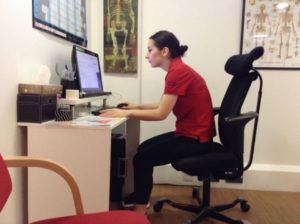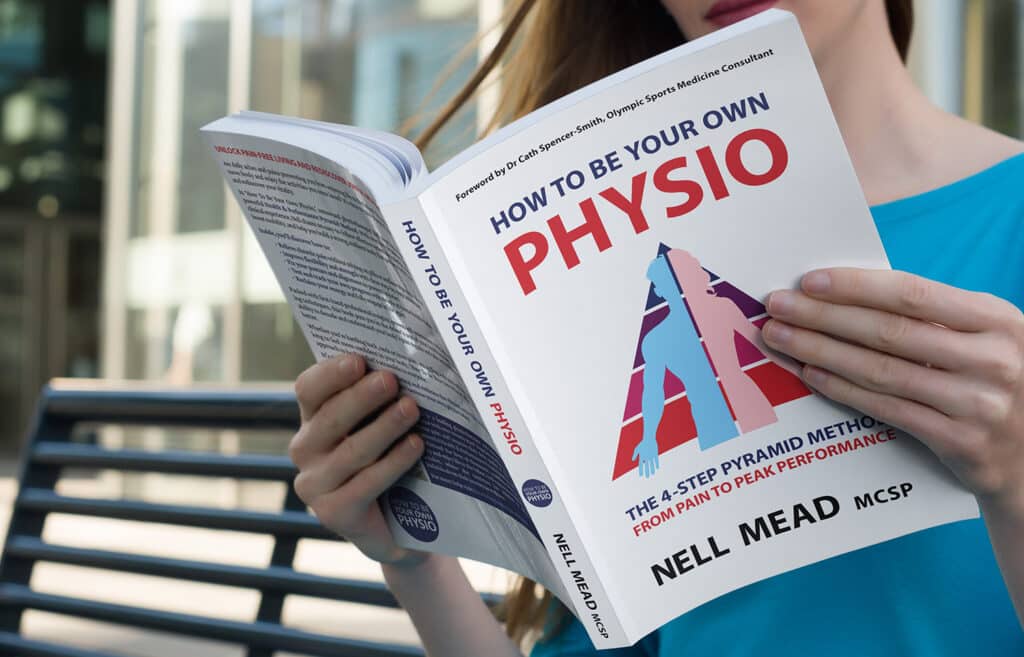According to research, the average Brit spends 9½ hours each day sitting down – 7-8 hours at work, then another hour or two in front of the TV.
That’s bad for us, for a whole range of reasons – in the long term it is associated with a higher risk of diabetes, depression, heart disease and obesity – but even in the short term, over hours or days, it can lead to problems including making you feel stiff and sore.
You may well start a sustained period of sitting in a terrific position, perfectly stacked, with your bottom well back in the seat, touching the back of the chair with your neck and shoulders, having your pelvis square, and your feet apart and flat on the floor… or, you might not. But whether you start well or not, after a while, you’re likely to end up slouching.
So, let’s have a look at the body parts that are put under stress when you slouch:
Head and neck
Firstly, your head should be stacked over your shoulders, with your ear vertically aligned over the tip of your shoulder. Unfortunately, many desk workers do the opposite (their head slouches forward and their chin pokes out), which puts pressure on the muscles that go from the back of the neck and down to the shoulders. This compresses the joints and discs in the back of the spine, causing muscle tension which restricts blood and nerve flow to the arms – and after a while, it just hurts.
Shoulders
Next, your shoulders. When your shoulders sit too far forwards for prolonged periods, with rounded shoulders and upper back, the back of your shoulder joint can become really tight. This pushes the ball of the shoulder forwards in its socket, putting pressure on the tendons and causing stress through your upper ribs and collarbones. This can lead to conditions such as rotator cuff impingement, carpal tunnel syndrome and RSI.
Upper back
You should aim to sit with your upper back leaning into the chair. Researcher Alf Nachemson found that sitting slouched (as in the picture above), puts 75% more pressure through the discs than standing upright, whereas sitting with your back supported actually reduces the pressure through your discs by 40% compared to standing upright. This is really important: sustained pressure through the discs can lead to major back problems over time.
Lower back
When you slump forwards in your chair, you lose the vital lordosis, or inward curve, in your lower back. Engineering research has shown that maintaining this curve is really important for shock absorption in the spine; whereas if you spend long periods sagging against it, the back wall of your spinal discs can weaken, increasing your risk of a “slipped disc”.
Hamstrings
Sitting on a chair puts your hamstring muscles at the backs of your thighs in a shortened position. That’s not an issue for short periods of time; but after a while, the hamstrings will adapt to the position and will physically shorten. When this happens, they start to tighten too quickly when you walk, and that can affect the glute muscles in the buttocks, making them get lazy and out of shape.
All in all, prolonged sitting is actually a really easy and efficient way to develop muscle imbalance around the pelvis and lower back, as well as to increase your risk of heart disease, diabetes, depression and obesity!
That sounds terrible, what can I do about it?
Many office workers throughout the UK are mentally chained to their desks. I see a lot of city traders who struggle with just this issue… multiple computer monitors which they stare at all day for many hours, with even trips to the coffee machine and bathroom being frowned upon in case they miss the pivotal moment to sell or buy!
We know that human bodies are designed to move, to hunt and gather – but how do we manage when our jobs don’t involve much hunting and gathering?
Well – the key concepts that will keep your muscles and joints healthy for the long term are based around flexibility, strength and endurance – all of which are reduced when we sit for long periods – and those are underpinned by the health of the tissues themselves; the bones, joints, cartilage, ligaments and muscles.
If we sit badly, then we develop the issues above – muscle imbalances, stiff joints, poor nutrition to our bones and cartilage. We can limit these issues by sitting better – feet hip width apart and flat on the floor, sitting with pelvis square, bottom well back into the seat, leaning back into the rear of the chair, and making sure both shoulders and head are back.
It helps to have a chair that moves with you and supports you, and we recommend the guys at Back in Action to help you choose the right chair for your body.
If we have to sit for long periods, we can’t simply rely on good posture and a good chair to be enough. Even with the best posture in the world, research shows us that after a period of two hours of sustained sitting, the height of your spinal discs is reduced by around 50%. We’re simply not designed for sustained compression, we really are designed for movement!
That’s why we’ve designed our online programme, Stretches for Desk Based Workers – a quick, easy, 5-minute programme that helps you to stretch out your neck, shoulders, back and hamstrings, and to wake up the buttock muscles (lazy glutes really are becoming epidemic, and lead to so many problems with hips, backs and knees).
Don’t wait until you start developing back problems and need to book in with us for physio, or (worse still) develop heart problems and have to stop working before you’re ready to retire! Prevention is much better than cure! The more you can move, the better for your body; but even if you do just one of our exercises for two minutes each hour, over time it will help to reduce the stiffness and fatigue that creeps in by the end of the day.








